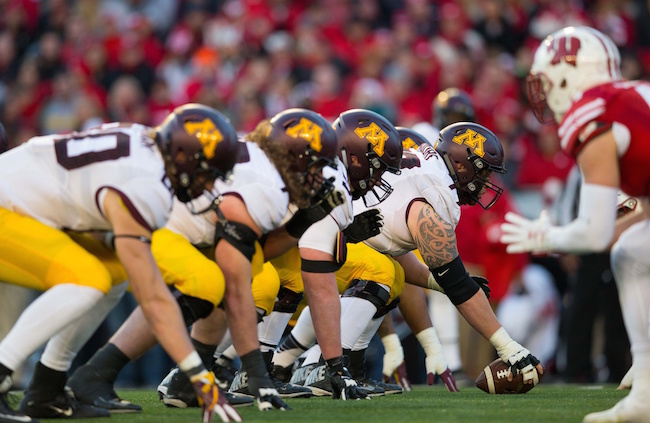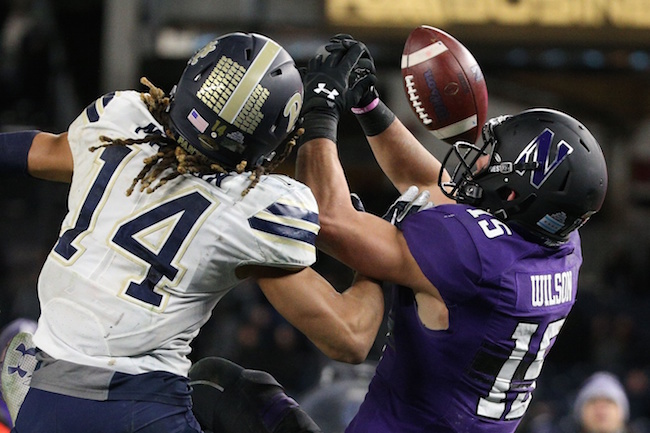Ad Disclosure
It doesn’t matter who you are. Every team has a weakness.
Even Alabama and Clemson had weaknesses last year. They have them this year, too.
So does the rest of the B1G. For now, we’ll start with the biggest weakness for every B1G West team.
ILLINOIS — Quarterback
Kind of a no-brainer here. As is often the case with Lovie Smith’s teams, the quarterback position is a major question mark. We do know that Chayce Crouch is the guy, but he’s coming off shoulder surgery. We also know that he has a different skill set than Wes Lunt. We saw that when he ran all over Purdue for 137 rushing yards in his first time getting significant snaps.
Garrick McGee is plenty familiar working with mobile quarterbacks. Don’t forget that he was at Louisville during Lamar Jackson’s first season as a starter. Will Crouch become Jackson? Don’t hold your breath. But if he can become a true dual-threat, Crouch won’t be the one holding the Illini back.
IOWA — Receivers
Here’s a trivia question. How many receivers on the Hawkeyes have a college catch? One. His name is Matt VandeBerg, and he’s still working his way back from a broken foot after he re-injured it in the spring. Jay Scheel, Jerminic Smith, Ronald Nash are all no longer with the program for various reasons.
So yeah, Iowa lacks receiver depth.
The Hawkeyes will get help from Akrum Wadley out of the backfield and tight end Noah Fant is a promising pass-catcher. But a first-year starting quarterback is going to need more than that. New Iowa offensive coordinator Brian Ferentz wouldn’t mind if JUCO transfer Nick Easley emerged as a reliable target. Getting breakout performances from Devonte Young or Adrian Falconer would be a blessing, as well.
Frankly, anyone getting open would be an upgrade from Iowa’s injury-riddled group in 2016.
MINNESOTA — Offensive line
How big of a mystery is Minnesota’s offensive line rotation? At times during the spring, the Gophers only had four healthy offensive linemen. New offensive line coach Ed Warinner worked with some different circumstances than he did at Ohio State.
Three Gophers who started in games last year (Garrison Wright, Vincent Calhoun and Jared Wyler) missed spring practice after recovering from offseason surgery. Donnell Greene started the final eight games for the Gophers, and he should provide a veteran presence.
But the issue with the Minnesota offensive line isn’t experience. It’s health and depth. P.J. Fleck’s ability to jump-start the offense is largely dependent on whether or not there’s quality offensive line play. It won’t matter who wins the starting quarterback job if the line is decimated by October.
NEBRASKA — Linebackers
With Nebraska switching to the 3-4, inexperience at linebacker doesn’t bode well. Fortunately for the Huskers, new defensive coordinator Bob Diaco has a history of maximizing talent at the linebacker position.
He’ll need to do that after the Huskers lost key veterans Michael Rose-Ivey and Josh Banderas. Chris Weber, Marcus Newby and Dedrick Young are now the veterans of the group, and none of them have been relied on as much as they will be in 2017. Outside of that, Nebraska could have to turn to some freshmen to play significant snaps. Four-star true freshman Avery Roberts could be thrown into the fire, as could Quayshon Alexander.
The Huskers need to be deeper than ever at linebacker for the 3-4 to be effective. It requires versatile players like Newby to make plays in the backfield and in coverage. Diaco has to find linebackers who can get to the quarterback and force mistakes. That’s what made his defense so successful in Notre Dame’s run to the National Championship in 2012.
From the look of it right now, Nebraska lacks a Manti Te’o.
NORTHWESTERN — Receivers
At this time last year, the Wildcats’ weakness was also its receivers. Then Austin Carr happened. Now, it’s about finding multiple receivers to fill his B1G Receiver of the Year-sized void.
Flynn Nagel has been pegged as the heir apparent to Carr, though that’s asking for a lot. Nagel has a similar frame as Carr and he actually had a more productive sophomore season (40 catches for 447 yards) than some might’ve realized.

Nagel, even if he makes a big leap, will need help. Losing speedster Solomon Vault to a season-ending injury hurt, but he likely wasn’t going to be a high volume guy. The Wildcats need production from Macan Wilson, who cracked the rotation regularly last year. The addition of Jalen Brown, a graduate transfer from Oregon, looms even larger.
Thorson took his game to another level in 2016, thanks in large part to the chemistry he developed with Carr. That might not happen with any one player in 2017, but Thorson needs to establish trust in several guys for Northwestern to take its offense to another level.
PURDUE — Defensive line
If you can’t stop the run, you aren’t winning in the B1G. Period. In the Darrell Hazell era, Purdue couldn’t contain the run, much less stop it. Allowing nearly 3,000 yards in 12 games is a sign of weak defensive line play. Purdue’s do-it-all defensive lineman Jake Replogle is gone, as is the underrated Evan Panfil.
Gelen Robinson made the switch to defensive tackle to take on multiple blocks and make stops in the backfield. He might not play there full time, but he could if he’s the only one capable of plugging gaps. Eddy Wilson and Lorenzo Neal will also be relied on even more to make plays from the interior.
New defensive line coach Reggie Johnson must also find ways to improve on Purdue’s paltry 1.75 sacks per game in 2016. Edge rushers are needed in West Lafayette. If Purdue can’t get production from its defensive line, it won’t matter how many points Jeff Brohm’s high-flying offense puts up.
WISCONSIN — Downfield targets
Technically, “downfield targets” isn’t a position. I get that. But Wisconsin has so much balance across the board that it doesn’t have one glaring weakness. It does, however, need to find guys who can stretch the field for Alex Hornibrook.
Rob Wheelwright was the downfield target when healthy. With him no longer around, Quintez Cephus and George Rushing could step into that role. Rushing has shown flashes, but he’s never been able to earn a regular spot in the rotation. Cephus, after what he went through this offseason, could have the best shot at developing the rapport with Hornibrook. Perhaps it’s A.J. Taylor who makes a big second-year leap.
What we do know is that Wisconsin has two of the B1G’s top offensive weapons in Jazz Peavy and Troy Fumagalli. Both of them do most of their damage within 20 yards of the line of scrimmage. To maximize their skill sets and give Hornibrook a chance to show off his deep-ball touch, the Badgers need to be able to take some shots downfield.
Wisconsin can run away with the B1G West, but that’ll only happen if it can find some guys who can get separation.
Connor O'Gara is the senior national columnist for Saturday Tradition. He's a member of the Football Writers Association of America. After spending his entire life living in B1G country, he moved to the South in 2015.


